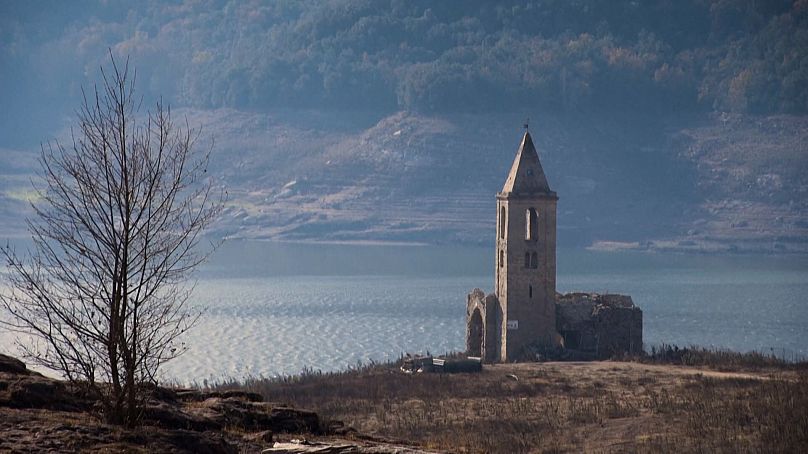A church in the sunken Spanish village of Sant Romà de Sau has emerged from the waters of a reservoir.
Flooded 60 years ago to form the Sau reservoir, which provides essential water supplies to the city of Barcelona, just the top of the church’s three-storey tower usually pokes up above the surface.
Now, the 11th-century building stands firmly on dry land and has started to attract ‘drought tourists’.
“It’s unbelievable how much the water level has gone down,” says Sergio Iberico who visits the reservoir often.
“I remember paddling here and the water level was at the window of the church tower.”
Current water levels in the Sau reservoir are at just 6 per cent of capacity. Last year at this time they were at around 19 per cent and the average for January is usually above 90 per cent.
Antonio Rodriguez, who lives close to the reservoir, says the falling water levels have left him worried for himself and his family.
“The water is running out. I already restrict my use of water, I only use what is necessary,” he says. “But we are running out of water.”
The church in Sant Romà de Sau is just one sign of a wider drought emergency that the country is facing.
Drought brings rising water bills and food prices
The regions of Spain worst hit by the prolonged drought are Andalusia and Catalonia - both of which are important agricultural and food-producing areas.
In Catalonia, the drought has been ongoing for three years and just 17 per cent of the region’s water supplies now remain. If that figure drops to 16 per cent, the government of Catalonia will have to declare a state of emergency and impose stricter restrictions on water usage for households.
Water bills have already increased and water use for agriculture is restricted. Parks are no longer being watered, fountains are dry and filling private swimming pools is not allowed.
Some gyms in the region have started charging an additional fee to use their swimming pools with some closing them entirely.
The impact of drought is also being reflected in the rising cost of fruit, vegetables and olive oil across the country. The price of olive oil in particular has reached a record high increasing by more than 50 per cent compared to last year.
Many Spanish shops have started to put security tags on bottles.
Can desalination solve Spain’s drought problem?
Barcelona is also home to Europe’s largest desalination plant which produces fresh water from the nearby Mediterranean Sea.
Laia Hernandez Lloret, a spokesperson for the plant, says without it strict water restrictions and a state of emergency would have been in place in the region at least six months ago.
Millions of tourists and residents of Barcelona would not have enough water.
“From 100 litres of saltwater, we get 45 litres of fresh water. At the moment, this desalination plant produces about 20 per cent of the freshwater Barcelona needs,” says the director of the Llobregat plant Carlos Miguel.
But, Miguel adds, they are currently operating at full capacity and can’t desalinate any more water.
Turning seawater into freshwater alone is unlikely to solve Spain’s drought problem. It is too slow, expensive and consumes a lot of energy.
Unless that energy comes from renewable sources, pollution caused by desalination will also speed up climate change which is contributing to the water shortages.
And yet as the problem persists, Spain is planning two new desalination plants in the hardest-hit regions of Andalusia and Catalonia.

